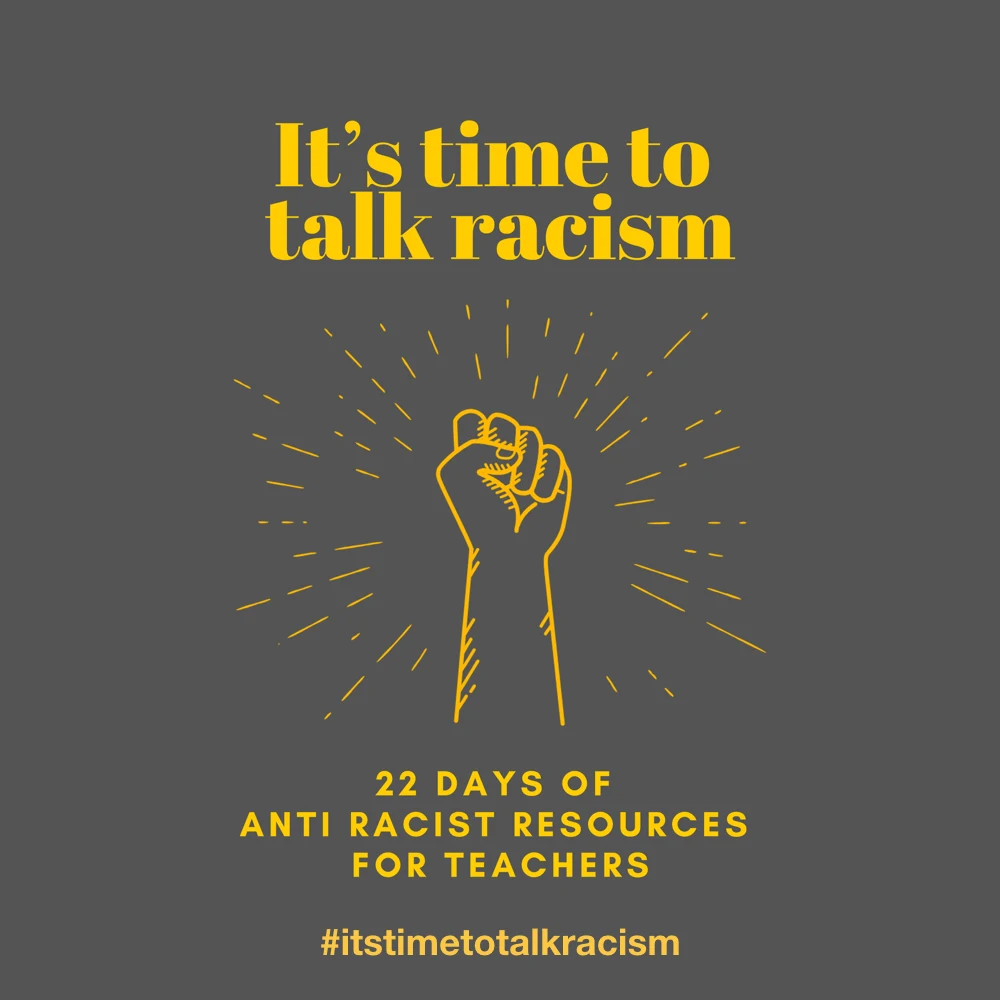 |
| Source: Buzzing with Ms. B. |
I emailed Chrissy from Buzzing with Ms. B., the coordinator of this 22-day campaign, to ask if my idea would be okay. She viewed the episode, Devil in the Dark, and said it didn’t really decenter whiteness.
Since I didn’t quite understand what “decentering whiteness” meant, Chrissy and I emailed back and forth as we delved into why that Star Trek episode didn’t do that. Because I think our conversation would be helpful to other educators, with her permission I am going to share some excerpts below. Following that, I’ll offer a link to a resource I created to help you select TV shows and videos that decenter whiteness. I’ll also discuss a book I recently read that would be a great read-aloud and discussion starter with your students.
Below are the sections of the email exchange I had with Chrissy that really made clear for me this idea of decentering whiteness. But -- spoiler alert! If you've never seen this episode of Star Trek, these excerpts give away part of the plot.
Chrissy: I've been thinking about the Star Trek episode, and I totally see where you're coming from with addressing biases and cultural misunderstandings.
I'm realizing that this episode does center whiteness. In other words, because it's from the perspective of the colonizers...and how they're being killed by this other thing, it's about the white experience in response to this new culture.
Susan: I see where you're coming from with that and I agree up to a point. But I also feel that it's Spock, who is bi-racial, who is the hero of the episode.
Chrissy: [T]he issue as I understand it isn't that the actors or writers are white or anything in that sort of vein. With this episode, the issue as I see it is that there was a group of people moving into a territory and the creatures there are represented as some kind of animal, even once Spock understands their perspective. My concern is that some people might see themselves as the Horta, an animal who, even when being described as being "highly intelligent" is the butt of jokes about her appearance.
The agreement that the crew and the Horta reach is actually only beneficial to the humans…. The humans are acting as colonizers, taking what they want, and agreeing to leave the natives alone, taking on the role of white savior to bestow that kindness on the Horta, even though she was fine before they arrived.
Susan: That makes a lot of sense, especially the part where you say it isn't about the writers or actors being white… And I see your point about how the Horta is described and how some people could internalize those negative comments.
That really makes things clear, in terms of where you're coming from with your analysis of this episode. I hadn't ever thought of Kirk and crew as being in white savior mode but it makes perfect sense from the way you've characterized it.
Chrissy: It's interesting that we can love shows and acknowledge that they were problematic, too. When people see that it's ok for our thinking to change (and it always does!), they can feel like it's ok for their thinking to change, too.
* * *
So I discarded the idea of sharing my Star Trek lesson with you. Instead, I decided to create a checklist you can use when you are looking for a TV show or video to show your students. It’s a list of questions that ask about the show, with space for you to write answers next to each question. You can find it HERE, where you'll be prompted to download a copy of the free checklist. Please note that I use the phrases "minority characters" and "people of color" interchangeably in the checklist.
 |
| Download your free copy HERE; source: The ESL Nexus |
Now I'd like to reccomend a book that would be a great addition to your collection of books that deal with racism, bias, stereotypes, prejudice, and how kids interact with people who are different from them.
With its traditional “once upon a time” fairy tale beginning and watercolor-ish full-page illustrations, from the stars in the sky to the fish in the sea is a beautiful picture book that will appeal to kids of all ages. It’s about fitting in, choosing who you want to be, and how to treat non-conforming people. It’s also about a mother’s love for her child. The song she sings every evening when her child recounts their negative experience in school will warm your heart.
This story has an important message that will resonate with all students who feel awkward and out of place in their school: English Language Learners, special needs students, gender non-conforming students, and every other kid who doesn’t fit into whatever is considered typical for where they live. I love this book and it should be in every teacher’s classroom library.
This post is in memory of Maribel Hernandos Campos, one of the 22 persons murdered in El Paso in August 2019 by a gunman who targeted people of Mexican heritage.
I am posting a link to each day's blog post in the #itstimetotalkracism campaign on my Facebook page and Twitter account. Please check them out for great teaching ideas and resources!

